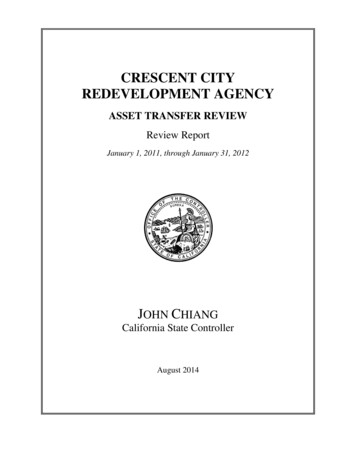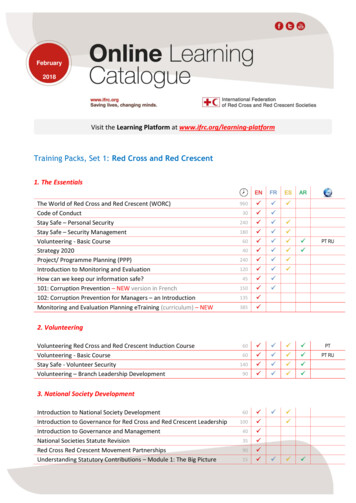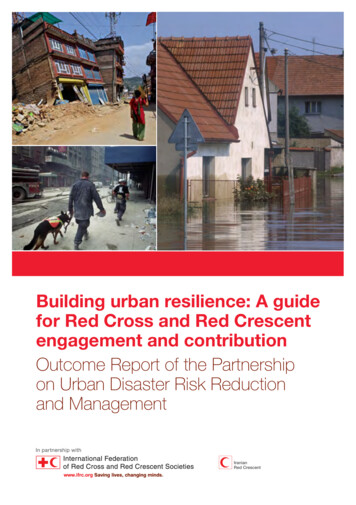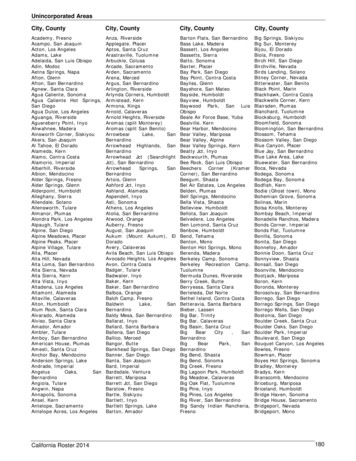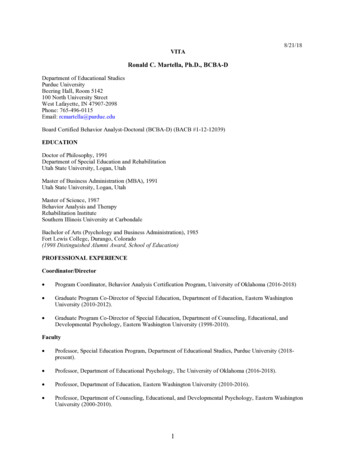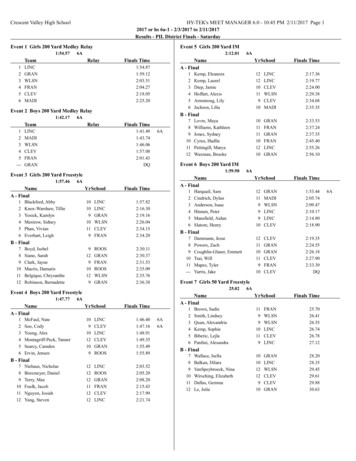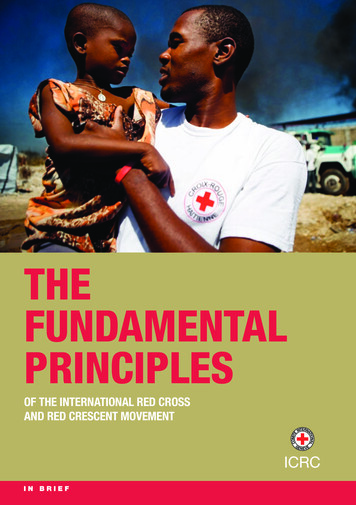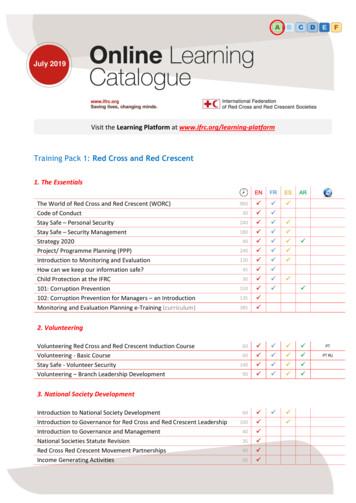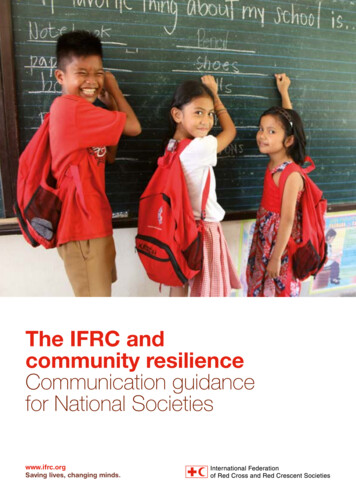
Transcription
City of La Crescent, MNThe Blufflands PlanNOVEMBER 2017“The La Crescent Community will establish an exceptionalnetwork of protected blufflands and recreational trails inand around the City of La Crescent. Our cooperative effortswill enhance the health of residents, visitors, natural ecosystems and our local economy.”- City of La Crescent Bluffland Plan Vision
iiLa Crescent. MN November 2017
iiiINTRODUCTIONPREFACEIn 2016 the County of La Crosse,the La Crosse Area PlanningCommittee (LAPC) and its regional municipalities, includingthe City of La Crescent, undertook an extensive processwith planning consultant MSAProfessional services, Inc. toprepare a plan for land conservation and recreational access in blufflands across theregion. The planning processincluded interviews with critical stakeholders throughoutthe region and several large,public meetings to collect input and help refine plan recommendations. The BlufflandsPlan was adopted by LaCrosse County and the LAPCand work continues in 2017to establish a formal, ongoingBluffland Coalition to pursuethe continued enhancementof our shared bluffland resources. The completed plan canbe viewed on the Planningpage of the La Crosse Countywebsite (see ing.asp).In 2017 the City of La Crescentrequested and received funding from the LAPC to engagethe same consultant teamat MSA to develop a morespecific ‘action plan’ for theMinnesota side of the river.The regional plan had identified some lands highlightedfor some method of conservation, and also a regionaltrail route around the City,but it lacked detail or prioritization of the various optionsfor protecting lands from development and improvingrecreation access.This plan provides that detail.It builds upon thepublic conversations andpolicy guidance of the regional Blufflands Plan, andalso the 2016 La CrescentComprehensive Plan, whichcalls for preservation of theblufflands and city vistas aswell as site-appropriate public access to blufflands recreational opportunities andsustainable management ofblufflands and parks. This planwas developed through consultation with a group of keylocal stakeholders familiarwith the issues and challenges of land protection and trailinvestment. Those stakeholders are listed below.It is important to note thatthis plan is a starting pointfor further discussions withbluffland landowners aboutthe conservation of highlyvisible and sensitive lands.Any protection that occurs,whether through conservationeasements or outright landpurchase or other means, willoccur cooperatively with willing property owners. Likewise,the plan identifies recreationimprovements that require future budgeting decisions andalso assistance from privatedonors and recreation advocates. This plan is intended tofocus those efforts such that amore cohesive system of trailsand recreation amenities isdeveloped over time. Furtherextending the theme of collaboration and cooperation,it should be noted that someof the lands identified in thisplan are outside the City of LaCrescent, in La Crescent andDresbach Townships. While thisplanning effort was City-led,implementation will requirecooperation among multiplejurisdictions. It is the hope andexpectation of the City of LaCrescent that by establishinga vision and gathering stakeholders to work toward thatvision each year, we can protect our valued blufflands forthe benefit of all current andfuture residents of our sharedcommunity. See the ActionPlan for details.The Blufflands Plan November 2017
ivAcknowledgementsThanks are extended to all those whocontributed to the development of thisplan. Linda Larson – City Resident, PlanningCommission Member Donald Smith – City Resident,Planning Commission Chair Jim Nissen – City Resident, Retired USFish and Wildlife District Manager Cheryl Jostad – City Resident, Bikeand Pedestrian Committee Member Mike Cunningham - City Resident,Bike and Pedestrian CommitteeMemberTable of Contents1BACKGROUND Nick Bancks – Minnesota Land TrustBluffland Conservation, Prior Planning, Trail Use & Design Hansi Johnson- Minnesota Land Trust17 Aaron Lacher – Houston CountyPlanning & Zoning DirectorAcquisition & Easements, Trail & Access Points, Signage Bob Cummings – La CrescentTownship Chairman and PlanningCommission Chair33IMPROVEMENTSIMPLEMENTATIONAction Plan, FundingThis plan is an extension of the City of La CrescentComprehensive Plan, adopted in 2016, which established many of the ideas in this plan based on an extensive process of community engagement and discussion.With assistance from MSA ProfessionalServices, Inc. Jason Valerius, AICP Steve Tremlett, AICP, CNU-ALa Crescent. MN November 2017
1B LU F F L A N DCO N S E R VAT I O NBACKGROUNDHISTORYThe La Crosse-La Crescentregion boasts a unique andbeautiful landscape featuringdramatic stone bluffs overlooking the Mississippi River.These lands and features arepart of a larger area knownas the Driftless Area or CouleeRegion, spanning portionsof 35 counties across southeast Minnesota, southwestWisconsin, northeast Iowa,and northwest Illinois. In theLa Crescent area these bluffsand associated highlands areknown by many as “Blufflands”.The bluffs were formed by theerosion of the surrounding valleys over tens of thousands ofyears, and, unlike much of thesurrounding region, they werenot smoothed flat by glaciersduring the most recent iceages and they lack the deposits of sediment “drift” typicallyleft behind by glaciers. Thisis the source of the “DriftlessArea” name.Geologically older and morevaried than the glaciatedareas, the bluffs host uniquebiodiversity.Accordingto Minnesota DepartmentofNaturalResources’sTomorrow’s Habitat ActionPlan, there are156 Species inGreatest Conservation Need(SGCN) known or predictedto occur within the Blufflands.These SGCN include 82 species that are federal or stateendangered, threatened, orof special concern.Scenic America (a nationalnonprofit dedicated to preserving bucolic vistas) labeled the Upper MississippiBlufflands as “one of the 10last chance landscapes”. Thislabel was given because theBlufflands are a naturally occurring, beautiful phenomenon that faces harm, but hasa “last chance” for preservation before it is lost or damaged.The primary “harm”facing the Blufflands is urbandevelopment that replacesopen spaces and naturalhabitats with structures, roadsand lawns, changing how thebluffs look and altering ecological conditions.The La Crosse-La Crescent region has grown in populationby roughly 40,000 people overthe past 40 years. As theregion continues to grow, ata rate of about 800 new residents per year, the Blufflandsface continued developmentpressure, especially for homes.The bluffland scenic views arean essential component of theregion’s identity - this beautyhelps draw people here, bothto visit and to stay. As people continue to move to theregion, and as La Crescentworks to attract a share of thisgrowth, it is important to protect and conserve the bluffland resource.The Blufflands Plan November 2017
2BluffBluff ToePhoto Credit: Mississippi Valley ConservancyBLUFF PROTECTIONIn Southeastern Minnesotain 1998, a Blufflands DesignManual was initiated byArchitecturalEnvironmentsof Dakota, the State ofMinnesota, and the WinonaCounty Planning Department.The manual addresses issuesconcerning growth and development within the Blufflandswith a focus on avoidingisolated residential housingdevelopments (urban sprawl)to preserve the region’s identity and natural resources. TheManual recommends toolsranging from comprehensivenewspaper coverage of regional land-use issues to zoningordinance recommendationsin order to preserve the bluffs.Although bluffland preservation has primarily been accomplished through land andeasement acquisitions, severalpublic entities in the regionhave worked to protect thebluffs through regulatory tools,using ordinances to preventdevelopment.Winona County OrdinanceBluff is defined as lands risingat least 25 feet above theordinary high water mark ofa shoreland water body (ifwithin 1,000 feet of a waterbody) or 100 feet from toeto top outside a shorelandarea, with an average slopeof 25% or greater. A Bluff impact zone is defined as including the bluff and landswithin 20 feet of the top ofthe bluff. The top of the bluffis defined as the clear breakin the slope, or, if ambiguous,it is defined as the upper endof a 100-foot segment withan average slope exceeding18%. Structures must be setback 100 feet from the topof the bluff. Vegetative clearing is not permitted, and thePlanning Department mayrequire restoration of screening where it is insufficient.TheWinonaLa Crescent. MN November 2017CountyBluff Toe and TopDefinitionsSource:Winona County ZoningOrdinance
backgroundBluff DiagramsSource:Winona County Zoning Ordinanceuse permit with strict standards on grading, lighting,color, materials, height, etc.Houston County OrdinanceBluff is defined as lands rising at least 25 feet abovethe ordinary high water markof a shoreland water body(if within 1,000 feet of a water body) or 50 feet from toeto top outside a shorelandarea, with an average slopeof 24% or greater. A bluff impact zone is defined as including the bluff and landswithin 20 feet of the top ofthe bluff. The top of the bluffis defined as the clear breakin the slope, or, if ambiguous,it is defined as the upper endof a 50-foot segment withan average slope exceeding 18%. Structures must beset back 40 feet from the topof the bluff and 25 feet fromthe toe of the bluff. Intensivevegetation removal is prohibited within 20 feet of thebluff top; limited pruning andclearing is allowed if it doesnot substantially reduce thescreening of structures or other facilities as seen from thewater.ordinance adds additionalprotections for the “MississippiRiver Bluffs”, defined as bluffswithin one mile of MinnesotaHighway 61. No developmentis allowed within 300 feet ofthe top of the bluff within thisarea, except as a conditional3and further defines the slopemust drain towards the waterbody.In the ConservationDevelopment District, theprincipal building shall be setback 30 feet from the top ofthe bluff.Township of La CrescentOrdinanceThe Township’s ordinance mirrors the Houston County ordinance, except that it definesbluffs as only those occurringwithin the shoreland, meaningwithin 1,000 feet of a lake orpond, and 300 feet of a riveror stream.In other areas itwould appear that the bluffrelated regulations do not apply, and development canoccur on slopes up to 24%.In discussion with the Townshipof La Crescent, the regulation was to mirror the County’sstandards. The Township intends to correct the noted difference in the near future.City of La CrescentOrdinanceThe City’s ordinance mirrorsthe Houston County ordinance, except that it definesbluffs as slopes 30% or greater from the toe of the bluff(to a point 25 feet or moreabove the high water level)The Blufflands Plan November 2017
background4 WISsiCOMisssipRirSENATYTY61 UNUN90§ Co Hwy 1COCOy RdOSNOl leCRVaTAs1100rnWIOTOWN OFDRESBACHBuLAESNNveSIINpiNMdsEXISTING PROTECTED BLUFFLANDS14 brosiaStThe Blufflands are unique landforms. For the purposes of this plan, “bluffland” properties are thosewith terrain at or above 700 feet in elevation. Asof 2016, more than 3,000 acres and nearly 240parcels of Blufflands have been protected in theLa Crosse - La Crescent Region. The portion ofthese lands in and near La Crescent includesabout 100 acres of City parks and nearly 60 acresof County Park (Apple Blossom Overlook).0ig h ts100ieHeAmAerLnWINONA COUNTYd ApERdshInMcEaegBlufRdfallert DyLA CRESCENTt HillsllH i llF irePaSt800NHiDrC irN E l m StusthN 4dySRdA uganesi drkDrStN W a l n u t StN 2nd StNN 1 st S tS 3 r d StS 4 th StLn)6"vd61 St14 Ce d a r D r16!(LE G E N DS 11th StSkunk Hollow RdMiles0.125Dr 00Other Trail12La nc e rS 1 4 t h St0Bluffland Trail (Existing Trail)Existing Protected Blufflands*La n c er B l v dW il l o w Stfort hN OF LAESCENTC o rnC l a u d i a AveAcres99.957.40157.3Ma i neDrSp r u c e D rniJuWel sh i rBlRd25")Cr es c en t AveT- 3 1 4per StVaOa k Terll eyS 7 th StS O a k Stf f DrS E l m StnHicLS Wa l n u t S tS M a p l e StS H i l l StStoS portS 1 s t StS 2 n d StkoB lu0oin t R dney Ps ma n s Va l le y RdMa in Stryv ie wStN 3 rd St011OwnershipCity of La CrescentWinona CountyHouston CountyTOTALenVsRnle29)"gcoSy c a m o r e S try DrBe ai c kotoJ o n a th a n L nHShH a r a l s o n LnOldN Ch e s t n u t StntceesCr [S Chestn u t StrsDillReN Ridge RdHp leDrHOUSTO N COUNTYNon-Bluffland* Parks, Conservation and/or Public Lands [Potential Bluffland Dry Prairie1000700County Boundary9008008008007009001000La Crescent. MN November 2017Pi neC re0(*) Bluffland Properties include those with110lands at or above 740-FT in elevation. 000( ) Easements may not be accessible to the public.1900Parcels511016
background5PRIORPLANNINGBACKGROUNDThis Blufflands Plan builds upon workand policies in the City of La CrescentCompehensive Plan, adopted inSeptember 2016.The Comprehensive Plan includesa series of Goals and Objectivesin service to the following NaturalSystems, Open Spaces and RecreationVision Statement, describing LaCrescent as residents desires it to bein the year 2035:“The City of La Crescent is knownnot only for its exceptional driftless landscape, but also its commitments to clean air, clean waterand environmental stewardship.By expanding public access to blufflands and waterways, addinguses that ehance utilization of Cityparks, and attracting businessesthat serve recreation needs, theCity has cultivated a reputation foroutdoor recreation opportunities.Recreational users have becomeactive participants in the sustainable management of the region’sparks, blufflands and waterways.”This Plan is an extension of theComprehensive Plan, offering detailsto define how the bluffland assetswill be protected and improved.2.4. Downtown La Crescent willserve as a trailhead for a systemof regional hiking, biking andboating trails.The following objectives from theNatural Resources, Open Spaces andRecreation section of ComprehensivePlan are especially relevant anddeserve reinforcement in this plan.2.7. Parks and trails in the region willbe clearly identified and easy tofind and navigate.1.2 Blufftopsoverlookingandvisible from La Crescent and theapproaching highways will bepermanently protected fromfurther development.1.3. Existing residential developmenton blufftops and hillsides in andaround the City will be obscuredby mature trees.2.8. As access to natural areasincreases, there will continue tobe wild and secluded places withlimited human visitation.4.1. City parks will include featuresaccesible by wheelchair and/orby visitors with limited mobility2.1. There will be more hiking andbiking trails and users in the bluffsaround La Crescent.2.3. Public access improvements tonatural areas will be designedto prevent or repair ecosystemdamage and will be long-lastingwith minimal maintenancerequirements.The Blufflands Plan November 2017
6backgroundThe Land Use Chapter of theCity’s Comprehensive Plan alsodesignates most of the landaround the City, including allundevelopedblufflands,as“Bluffland Conservation” (see themap on the following page) andfeatures the following languagedescribing the City’s land useintentions for that area:The Bluffland Conservation (BC)category is intended to protect fromdevelopment most of the blufflandsimmediately surrounding the City,and especially those blufftops visiblefrom the City and the approachinghighways.The development of new housing isdiscouraged in areas designated asBluffland Conservation Area. Thepreferred development density isno more than one (1) dwelling unitper twenty (20) acres of contiguousland under single ownership.In limited cases, the use ofconservation subdivisions or clusterdevelopments may be acceptable.The development of commercialand manufacturing uses is stronglydiscouraged in BC areas, withthe exception of agricultural orrecreational businesses.The City is strongly opposed to anynew buildings or site clearing onbluff areas visible from the Cityand the approaching highways,including all of the State and Federalroutes.Any new development in lessprominent areas shall be located inLa Crescent. MN November 2017order to minimize its visibility fromthe County highways and townroads, in order to protect these“secondary” corridors that todayoffer exceptional scenic beauty.The City is opposed to any newmining, agricultural, or businessuses in this area that woulddramatically increase truck trafficthrough City neighborhoods
backgroundoreVetr63ansRdeRdW IS CON SIN ³B ue hl eV a ll e y Rdr RiA I RP OR TdgMI N NE S O TAFuture Land Use MapCity of La CrescentComprehensive Plan(2016)1RO A DT-DrA l Mo7LA KE S H OR E D R I V ELanes1T-90§ OA DFA N TA REED R803yH I NK LEY R OA DCROSSINEOCtNhRdosintMcn StSt61 S t ru pprkPaP E T T I B O NES El m S tS H i ll S tLan ce r B lv dH ol l ow R daiS 6th StC e d ar D rS to n e y P o i nt R dLa ³S y c am o re S tathoJohnC r esBeckman R dlenLnwTostEaTo wn H al l R d ³dsRansEvreunLA CROSSEHO US TO NAcSkMDRIVE 14/61kRS e lk e dRddTs ch um pe r Ree11t h S t12t h S tS pr uc e D rH i ll25StN 3r d S tN 2n d S tN 1st S tMa in S tS 1s t S tS 2nd StS 3r d StS 4 th S tV al le yS e lkorh StN 4tH il lStB l u ff DrShDrRdek Rd6R ed A p p29ntllCresgeHaPineillce ntHaH ³DrllRdReWe s t T o w nNDraAWINONAHOUSTONBAINBRIDGE ST R EETlleLA C R E S C E NT S T R E E TVaWsA mb ros iaBnurT RE E TOLIVET SEC H U RC H D R I VLARdPfefferValle16VUyRd21dLo re n z R ³26UVSource: Esri, DigitalGlobe, GeoEye, i-cubed, Earthstar Geographics, CNES/Airbus DS, USDA, USGS,AEX, Getmapping, Aerogrid, IGN, IGP, swisstopo, and the GIS User CommunityFUTURE LAND USECITY OF LA CRESCENTHOUSTON AND WINONA COUNTIES, MNPlanning AreaNeighborhood ResidentialDowntown Core Mixed UseConservation/Open SpaceJuly 2016 City BoundaryDowntown ResidentialCommercialParks & RecreationCounty LineRural Residential (Township)Private RecreationBlufflands Conservation AreaParcelShoreland Mixed UseIndustrialAgriculturalWaterDowntown Mixed UsePublic & InstitutionalDevelopment LimitationsPrinted by: stremlett, File: P:\12700s\12750s\12759\12759001\GIS\12759001 FutureLandUse.mxdDATA SOURCES:CITY LIMITS PROVIDED BY HOUSTON COUNTY.PARCELS PROVIDED BY HOUSTON AND WINONA COUNTIES.COUNTY LINES PROVIDED BY US CENSUS (2013).ROADS PROVIDED BY MNDOT AND LA CROSSE COUNTY.AERIAL PROVIDED BY ESRI.E0750 1,500Feet3,000Print Date: 11:20:46 AM 7/28/2016The Blufflands Plan November 2017
8backgroundRegional Bluffland Planning EffortR ecreDSANe BLUFFLhtation&Conos e r v a tinTHE BLUFFLANDS:A Plan For Conservationand RecreationThroughout the LaCrosse - La CrescentRegion (completed2016)THE BLUFFLANDS plan wasan initiative of the La CrosseArea Planning Committee(LAPC) to organize a regional approach to the conservation and recreational useof our blufflands. The LAPCassembled for this planningeffort a steering committee representing key City,County and Town/Townshipcommunities, plus the SevenRivers Regions Outdoor Recreation Alliance and Mississippi Valley Conservancy. Itwas developed to be usedby public and private stakeholders throughout the region to guide the acquisitionof conservation land andeasements, coordinate restoration activities and recreation access improvementssuch as trailheads and trails,and establish an organizational structure for continued regional coordinationand action.A broad Coalition was recommended in the plan, toensure the continued engagement and coordination of all parties that havea stake in the success ofThe Blufflands. Two typesof membership were suggested - Charter Membersand Associate Members. Itis a central function of theproposed Coalition to facilitate discussion among corestakeholders whenever apotential acquisition is to beconsidered. The purposes ofthis discussion are to evaluate the importance of theland as suggested by thisplan, to determine likely recreational uses (again withguidance from this plan),and to identify which entities should be involved in theacquisition process. Afterthe initial discussion aboutthe parcel, a land trust mayor may not be involved inthe acquisition, dependingupon the need to establishLa Crescent. MN November 2017a conservation easement(as is the case for lands acquired with the more conservation-oriented fundingsources) and whether theacquisition fits the mission,priorities and interest of aland trust.Per this completed regionalplan, La Crescent could beeither a Charter Memberor Associate Member, forpurposes of funding, coordination and participation.Charter Members wouldmake specific funding commitments (most of that tobe spent locally) and havea greater opportunity tobenefit from that Coalition,including access to regionalized funding assistancefor specific improvementprojects.See the 2016 LAPC BlufflandsPlan for more detail.If a Bi-State “Blufflands” Coalition is notformed, the City of LaCrescent should workto establish a grouprepresenting municipalities and countiesfrom Winona to theIowa border.
background9TRAIL USE& DESIGNBACKGROUNDIt is a fundamental premiseof this plan that the blufflandsare a valuable recreation resource, to be used for walking,running, hiking, biking, crosscountry skiing, snowshoeing,picnicking, wildlife observation(e.g. birding) and more. Theseactivities benefit recreation users individually, and the City asa whole by attracting visitorsand residents.Recreational use in the blufflands is almost entirely abouttrails. This section offers guidelines on trail use and design toassist in site selection and recreational use programming.Trail Use Compatibility andConflict ManagementThe Blufflands can host manydifferent types of recreationalactivities. An understanding ofthe compatibility of those usesis the foundation for trail designdecisions and the effective distribution of uses across the region.As documented in the regionalBlufflands Plan, conflict occurs when the goals of onerecreation participant interfere with the goals of anotherrecreation participant in thesame location. For example,the goal of a mountain bikerto ride fast through a forestmay conflict with a day hiker’s goal of a tranquil strollthrough the same forest. Theactual amount of conflictthat occurs when the hikerand mountain biker encounter one another is dependenton a host of factors, includingeach user’s experience level, previous experience withsimilar situations includingthe frequency of encounters,feeling of attachment to thetrail they are riding, design ofthe trail, proximity to one another, duration of their meeting, and tolerance of the other person’s behavior.Recreation activities interactin a variety of ways. Someactivities positively impactone another and are complementary.For example,campingincreaseshik-ing activity on nearby trails.Other recreation activitiesare merely compatible, having a neutral impact on thepursuit of another recreationactivity. These activities arecalled supplementary. Mostactivities, however, have thepotential for conflict with other activities. Users from thesedifferent groups may experience conflicts over competition for space, trail infrastructure, viewscapes, andsoundscapes. In minor cases, these conflicts are calledcompetitive interactions. Inmore extreme cases, two activities may be completely incompatible and interactionsbetween them are describedas antagonistic.The regional Blufflands Plancites work and findings bythe Wisconsin DepartmentofNaturalResources(DNR) for Wisconsin’s StateComprehensiveOutdoorRecreation Plan (SCORP),which is relevant in LaCrescent. Based on a seriesof focus groups with recre-The Blufflands Plan November 2017
10backgroundational use experts, includingrecreationmanagers,Wisconsin DNR staff developedCompatibility Ratings and organized them into a table(shown below) that describesthe perceived level of conflictfrom the perspective of users.Green shading representsgenerallycomplementaryrecreation interactions, whilered shading represents generally antagonistic interactions. The primary take-awayis that motorized recreationaluses are not very compat-ible with non-motorized recreational uses.Successful management mustseek to understand and mitigate conflict, and focus oncompatibility. Those uses thatfall in the “somewhat com-Spectrum of Interaction Types and Their Recreational OutcomesSource: WI DNR 2005-2010 SCORPInteraction TypeKey ng compatibility with increased useNo conflictHiking and campingSupplementaryNeutral interaction - no impact on compatibilityMinor conflictHiking and birdingCompetitiveDecreasing compability with increased useConflictHiking and mountain bikingAntagonisticActivities completely incompatibleStrong ConflictHiking and ATV ridingSource: WI DNR 2005-2010 SCORPAverage Recreation Activity Compatibility RatingsSource: WI DNR 2005-2010 SCORPLa Crescent. MN November 2017
backgroundpatible” (with ratings of 4.0-7.0for both uses), such as mountain biking and hiking, havethe greatest potential for improved compatibility.It is a recommendation of thisplan that the most challengingbike trails, including freerideand downhill single-track trailsare not compatible with otheruses and should be locatedaway from the most heavilyused trailheads to minimizeconflicts with other uses.It is also recommended thatthe City should continue to include some hiking-only trailsin more secluded areas thatserve the interests of thoseseeking solitude and wildlifeviewing opportunities.Trail SpecificationsTrail design parameters (e.g.width, material, maximumslope, etc.) are offered here toguide decisions on which landsto add to the City blufflandnetwork, how to fund those acquisitions, and how to improvethem for recreational use.Best Practices - All Trail TypesIn general, all trails should beconstructed as loops ratherthan out and back, exceptfor those connecting trails orfollowing a linear greenwayor existing path. As trails aredeveloped and improved, themost convenient and accessible trails should typically bethe easiest ones, meaning flatto shallow slopes and shortloops (“green circle” routes).More challenging trails, inslope and length, can be located anywhere – populartrailheads should offer access to a range of difficulties.Trails should be sited anddesigned to avoid the development of rogue trails.This means avoiding routesthat offer an easy shortcutbetween two points, eitherby limiting the use of switchbacks and/or by designingaround or adding vegetationwhere rogue trails are likely tooccur.The standard vertical clearance for any trail is at least 9feet, and those trails requiring grooming (such as crosscountry skiing) needing upto 15 feet vertical clearance(depending on groomingequipment).Even thoughthe criteria below are listedby individual trail types, it ismore efficient to allow formultiple user groups on individual trails. Therefore, themore restrictive recreationtrail standards should applyto shared use trails.The ideal trail grades vary depending on recreational usergroup, as well as trail type/material. For the purposes ofthis review, trail grades arecategorized as described inthe callout box above right.Trail construction on grades11Trail SlopeFlat ( 5.0% slope)Shallow (5.1%-10.0% slope)Moderate (10.1%-25.0% slope)Steep (25.1%-40.0% slope)Very Steep (Over 40% slope)over 75% is difficult and expensive to build and maintain, and thus, are not recommended for trail construction.Soil composition is also important to trail construction withsandy soils being very poortrail base and clay soils beingthe best and most sustainable.The general rule is the fewerthe amount of binders (clay)in the soil the lower compaction rate, resulting in highermaintenance needs. Binderscan be added to soils to makethem more sustainable, butthe majority of the time mostbinder applications will notwork on trails with grades overfive percent.Trailhead amenities, specifically bathroom facilities, arelargely dictated by cost ofconstruction and maintenance. The general rule ofthumb is the higher the expected use, the more needthere will be for rest room facilities at a trailhead. For example, rest room facilities withflush toilets are recommendedat any trailhead that is botheasily accessible (i.e. at theedge of an urban neighborhood) and providing accessto multiple trails. Conversely,The Blufflands Plan November 2017
12backgroundTrail Specifications by Recreation Use SummarySource: Trail Design Specialists, from The Blufflands Plan for the La Crescent erialGradePotential Shared UsesFoot TrafficPaved / Compact GravelFlat - Shallowbicycle, hiking, skateboards, rollerblades, runners, wildlife viewing0.25-10.0Natural SurfaceFlat - Shallowrunners, cross country cyclists9.00.25-10.0Natural SurfaceFlat - Very Steeprunners, cross country cyclists6-109.01.8; 3.1; 6.2Natural / Compact GravelFlat - Shallow 1.59.01.8; 3.1; 6.3Flat - Steep2.5-4.09.00.25-1.0Natural SurfaceNatural Surface (paved /compact gravel)Bicycle Traffic7.09.01.0-5.0urban1.5-4.09.0 5; 15; 30-50 Natural Surfaceless urban1.5-4.09.0 5; 15; 30-50 Natural SurfaceFreeride 2.09.00.5-2.0Natural Surfacewalkers, hikers, runners, birding/natureviewingwalkers, hikers, runners, birding/natureModerate - Steep viewingModerate -VerySteepdownhill cyclistsDownhill 3.09.00.06-0.5Natural SurfaceSteep - Very Steep free ride 6.0-12.0 (4.0/ .00.5-3.0Natural Surfaceless urban1.5-4.09.010-15Natural SurfaceWalking6.0 9.01.0-5.0urban1.5-4.09.0less urban1.5-4.0urbanless urbanHiking (day use)RunningWildlife Viewing(including Birding)UrbanPaved / Compact GravelFlat - ModerateFlat - Shallowwalkers, cross country cyclistswalkers, wildlife viewing, cross countrycyclistsnonebicycle, skateboards, roller blades,runnersCross CountryWINTERSnowshoeingCross Country Skiing(groomed trails)Skate
"The La Crescent Community will establish an except ional network of protected bluflands and recreational trails in and around the City of La Crescent. Our cooperative efforts will enhance the health of residents, visitors, natural eco - systems and our local economy." - City of La Crescent Blufland Plan Vision NOVEMBER 2017
